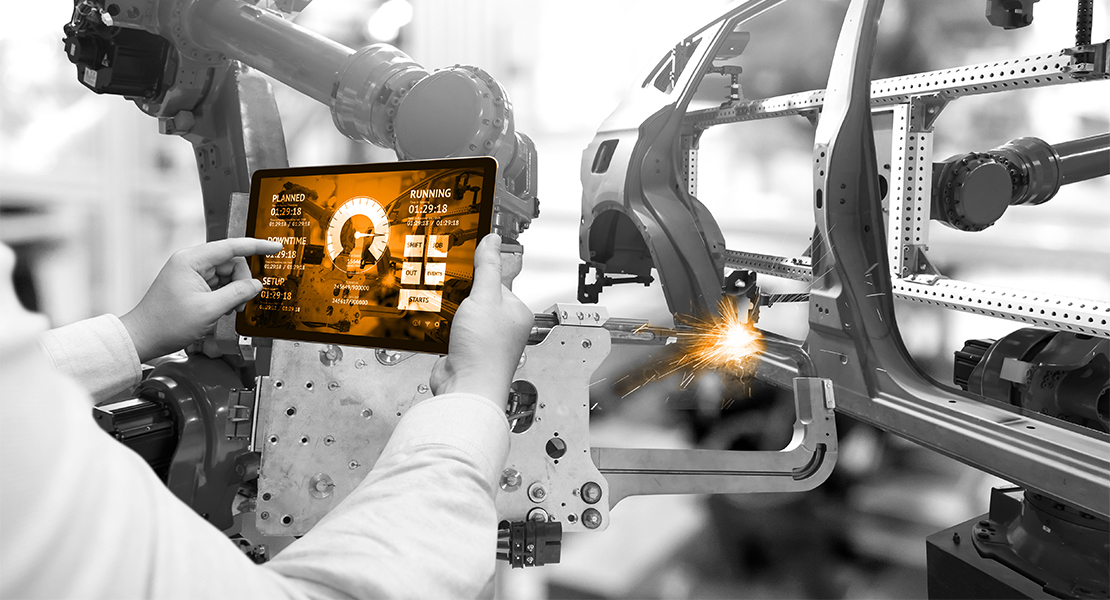The global crisis has had a massive impact on the manufacturing industry. When supply chains break down and machines are idle, we might have the time to consider how crisis situations like this could be more skillfully managed by exploiting even more of the opportunities arising from digitalization and automation.
VW, Porsche, BMW, Daimler, or Opel – the production shutdown of recent weeks is slowly coming to an end as the automotive industry begins to rev up operations once again. In mid-March 2020, the crisis had “reached the heart of German industrial production,” wrote the Handelsblatt. The number of suppliers’ machines that were turned off rose as well. A quick poll conducted by VDMA among mechanical engineering companies in Germany with the participation of around 1,000 respondents revealed that per the end of March, 84 percent of those surveyed had already been forced to deal with significant disruptions of their operations.
An end is not yet in sight. Based on the information available at the beginning of April, the Federation of German Industry (BDI) expects a decline in gross domestic product in Germany of three to six percent in 2020. BDI CEO Joachim Lang noted that this projection assumed an interruption in economic activity of no more than six weeks. The consequences that machine manufacturers and others are drawing from the loss of revenues are understandable, but risky. Almost three-quarters of the companies want to cut back on investment projects for 2020, half in the range of 10 to 30 percent and about one-fourth in a scope of more than 50 percent. One of the most urgent goals once the crisis has passed will be to “jumpstart investment activities,” said Dr. Ralph Wiechers, VDMA chief economist.
Over-extended supply chains
That is how things look at the moment. What sectors and processes in the manufacturing industry have been adversely affected, yet could be helped by shifting to strategies and digital solutions that will increase productivity and boost company revenues – not just in the current crisis, but in the long term as well? How about supply chain, full automation, maintenance, networking, distribution, and administration?
The weakness of the JIT/JIS (just-in-time/just-in-sequence) supply chains in the automotive industry (which focus narrowly on efficiency and minimizing tied-up capital) has been mercilessly exposed: a chain is only as strong as its weakest link. When supply chains have been scheduled with such extremely precise timing over a series of stages, the failure of only one supplier to meet its obligation “just in time” causes the entire chain to break down.
The situation is not yet quite so dramatic in the machine construction industry. Sixty-one percent of the surveyed machine builders to the quick poll conducted by VDMA on 28 March 2020 said that they could avoid disruptions in the supply chain to some extent by turning to alternative suppliers. However, one in five machine manufacturers has no alternative and would have to suspend production once stocks of components that cannot be replenished have been exhausted.
Supply chain needs transparency
What should companies learn from the crisis, and how can they adapt more quickly to changing market conditions? First of all, they must rethink their supply chain, especially those sections that have been raised to an untenable level of complexity. The chain has now become so fragile that even a restart after a crisis will not be easy. When we consider that building a car requires more than 10,000 parts or that a PC consists of several hundred individual components produced by innumerable suppliers around the world, it becomes self-evident that the supply chain cannot be switched on just by pressing a button. One country may have mastered the crisis and its suppliers are producing again while another country is still struggling with a full-blown epidemic. We see this happening at this very moment; for example, plants have resumed operation in China, but lack components from European manufacturers.
Rectifying this failing, however, will not be possible unless supply chains become more transparent than is frequently the case today. What car manufacturer really knows which tier 2, 3, or 4 supplier is in the supply chain or what and where exactly it manufactures its products? Digital supply chain solutions in combination with the trust of a partnership-based collaboration model can create this transparency. All participants in a chain have access to data that they can use for more extensive digital collaboration, greater accuracy in production planning, management of their own inventories, and in turn more precise steering of their own suppliers.
End producers and suppliers should rethink their supply chains and distribute the risks and costs of warehousing across the board. At present, suppliers and logistics companies shoulder most of the risks alone. Working together as partners instead of squeezing out even minimal savings potential appears to be the right path to follow into the future. Jointly operated interim storage facilities with greater capacities could also result in initial improvements. Another step, especially for critical components that one single supplier may not be able to stock in large quantities, would be the establishment of contacts to multiple suppliers (once a common practice).
Expansion of automation
Many production sectors in the manufacturing industry have been largely, even fully automated. This is true of some sections of the production process, at any rate. But there is still dormant potential that can be mined by using industrial IoT; remote control of machines is only one example. It would permit more production processes to continue running without a human presence at the machine. This can probably be realized only to a limited extent during final assembly. But there is still room for improvement in the production of preliminary products and components in terms of fully automated processes interconnected through digital technology.
Digital twins – complete virtual duplicates of the real world – have a special role to play. They can replicate production machines and their processes as well as components, workpieces, and finished products. Logistics and production processes can be simulated, weak points identified at an early stage, and the control of production optimized along the full length of the supply and production chain, even across corporate boundaries.
The results of the IDG study “Internet of Things 2019” show that the automation sub-sector of IoT is gaining ground – but more as an evolutionary process. After all, a good half of the companies surveyed for the study now rate the relevance of IoT as high to very high. One-fifth of the companies have realized their first IoT projects. But only four percent of the companies are planning a broad roll-out or have already completed one. The reasons given for this rather hesitant implementation include a lack of relevance, different priorities, immature technology, or excessive security risks.
From today’s standpoint, however, these reasons are difficult to understand. What is truly astounding is the argument of lack of relevance. In the same study, well over two-thirds (68.9 percent) of the respondents stated that they were satisfied or very satisfied with the results of the IoT projects they had carried out. It would be disastrous if the crisis were to push priorities for the introduction of digital technologies even farther down the list.
Remote maintenance and over-the-air updates
In the manufacturing industry, the maintenance and repair of machines play a decisive role for the prevention of disruptions in production processes. This is especially the case for wear and tear parts. Activities such as the replacement of drill bits or milling heads can be performed by robots, raising the level of automation and remotely handled maintenance tasks. Above all, however, using the right sensor technology in conjunction with digital processing of the sensor data identifies maintenance requirements at an early stage so that preventive maintenance that does not require the presence of a human being on the shop floor to inspect the condition of the machines and tools can be carried out.
What's more, the increasing proportion of software-controlled machine functions means that these maintenance activities can be carried out completely remotely. Provided that the required online connections are available, software maintenance takes the form of over-the-air updates (OTA). In the automotive industry, OTA is increasingly used for the products themselves and not only in production. Instead of sending vehicles to service centers for necessary ECU updates – whether “normal” maintenance or recalls – OEMs can read out information from the on-board electronics in the vehicle and install new functions remotely. This takes place in the background without inconveniencing the vehicle owner. Cost savings for maintenance work are not the only advantage; new functions (Function on Demand/Digital Retrofit) can also be installed via over-the-air updates.
Already common practice at Tesla for years, OTA is attracting increasing attention from carmakers. Beginning in August 2020, GM will use a new electronics platform that updates software the same way smartphones are updated. And Ford wants to equip newly developed vehicles in the USA with OTA update functionality for almost all ECUs. Volkswagen offers this functionality in the new Golf 8 and in its electric models of the new ID series; more models will follow. Other German OEMs are planning to make the same move. In many cases, however, only a few carefully chosen control units will be equipped with the function, but not, for the moment, the sensitive controls for engine electronics and other safety-relevant functions. As (partially) autonomous driving continues to develop, there will undoubtedly be a major technological leap forward in this respect in the near future. A majority of the service center appointments still necessary today will become superfluous (most of which are currently impossible anyway thanks to the coronavirus), but that will be dependent on the option having been installed in a large number of vehicles on the market. Above all, the success or failure of this concept is inextricably linked to finding an answer to the issue of cybersecurity. OTA updates require completely new levels of software security to prevent manipulation and third-party intervention.
Campus networks and self-operating machines
Cyber-physical systems (CPS) control complex production processes today. They are adaptable and transformable, qualities that translate into their playing a part in increasing efficiency. For instance, process speeds can be increased. Furthermore, processes generally run automatically and largely autonomously. Humans perform solely control and steering functions. CPS is a key building block of Industry 4.0. and can continue production even when people cannot be present owing to viruses or other reasons.
Autonomous (that is, self-operating systems) are controlled via real-time data interchange. Wireless network technologies available up to now have reached their limits. Networks based on Wi-Fi were not adequate for real-time data transmission. A lack of range forced the rollout of closely meshed hardware components in large production facilities and warehouses or on spread-out factory premises. Even then, the quality was insufficient for the control of self-operating machinery and transport robots over longer distances, especially since signals were interrupted at the transfer points from one transmitter to the next.
This is now changing with the deployment of 5G wireless networks in production, the 5G campus networks. The first manufacturers are already planning the use of industrial 5G in their production facilities. They are aiming to heighten the flexibility of production and to increase the level of automation – for example, by installing driverless transport systems (AGVs). The use of autonomous transport systems and vehicles that respond intelligently is growing; the units know the layout of the sites and, in the event of a problem, independently select alternative routes so that they can continue to supply materials to production lines.
Digital customer journeys for sales and service
What does the crisis teach us about contact with customers? Here, too, the advantages of digital customer touch points become obvious when personal contact is banned and there are mandatory closures of sales rooms and service centers. OEMs, dealers, and other companies in the automotive and manufacturing industries who have already created opportunities for digital communication with their customers and – in B2B business – with their partners are able to stay in touch even during the crisis. In this respect, the entire industry still has a lot to learn from other sectors, above all from telecommunications and end-consumer industries. In the manufacturing industry – especially in the typical “German medium-sized businesses” – the widespread attitude that sales and support in the B2B sector can be provided solely through personal contacts still dominates.
The crisis has clearly revealed that the argument of personal contact is no longer the decisive factor. Obviously, young end customers, “digital natives” who in any case prefer digital communication channels, recognize the potential for B2B business and the maintenance of relationships with partners inherent in video conferencing and other collaboration tools such as MS-Teams, Skype, WebEx, Zoom, or WeChat (just to mention a few), but corporate employees see the opportunities as well. They include the maintenance of long-established relationships and stabilization of loyalty as well as the acquisition of new business in sales.
CEO, CIO, or COVID-19
Companies that are able to serve their customer touch points digitally and whose employees are experienced in handling digital communications will enjoy a major competitive advantage. The question currently making the rounds in social media, originally intended as a joke, is acquiring a much more serious and profound meaning: Who in your company has pushed digitalization: a) CEO, b) CIO, c) COVID-19?
And finally, the crisis has shown that even in the manufacturing industry digitalized office work and New Work approaches can keep the management and administration of the company running seamlessly. Any elements of added value whose creation is not dependent on machines on the factory floor can be realized (for the most part) by people working from home – even without personal meetings. This is subject, of course, to the provision of the required communication infrastructure and collaboration tools such as video conferencing and the conferencing services mentioned above in conjunction with the essential mindset and skills of employees in utilizing these tools.
Manufacturing: strengthened by the crisis
Although the manufacturing industry is one of the sectors that have been hit hardest by the coronavirus crisis, it has as well the opportunity to learn from this and, in particular, to exploit more extensively the opportunities offered by digitalization. Obviously, they must be turned into preventive measures to guard against the next crisis, which – hopefully – will not arise any time soon. But they must also be regarded as the chance to take advantage of digital technologies and the associated organizations and processes in general. In the end, the crisis will – perhaps – have its good side: the acceleration of digital transformation in the automotive and manufacturing industries.







